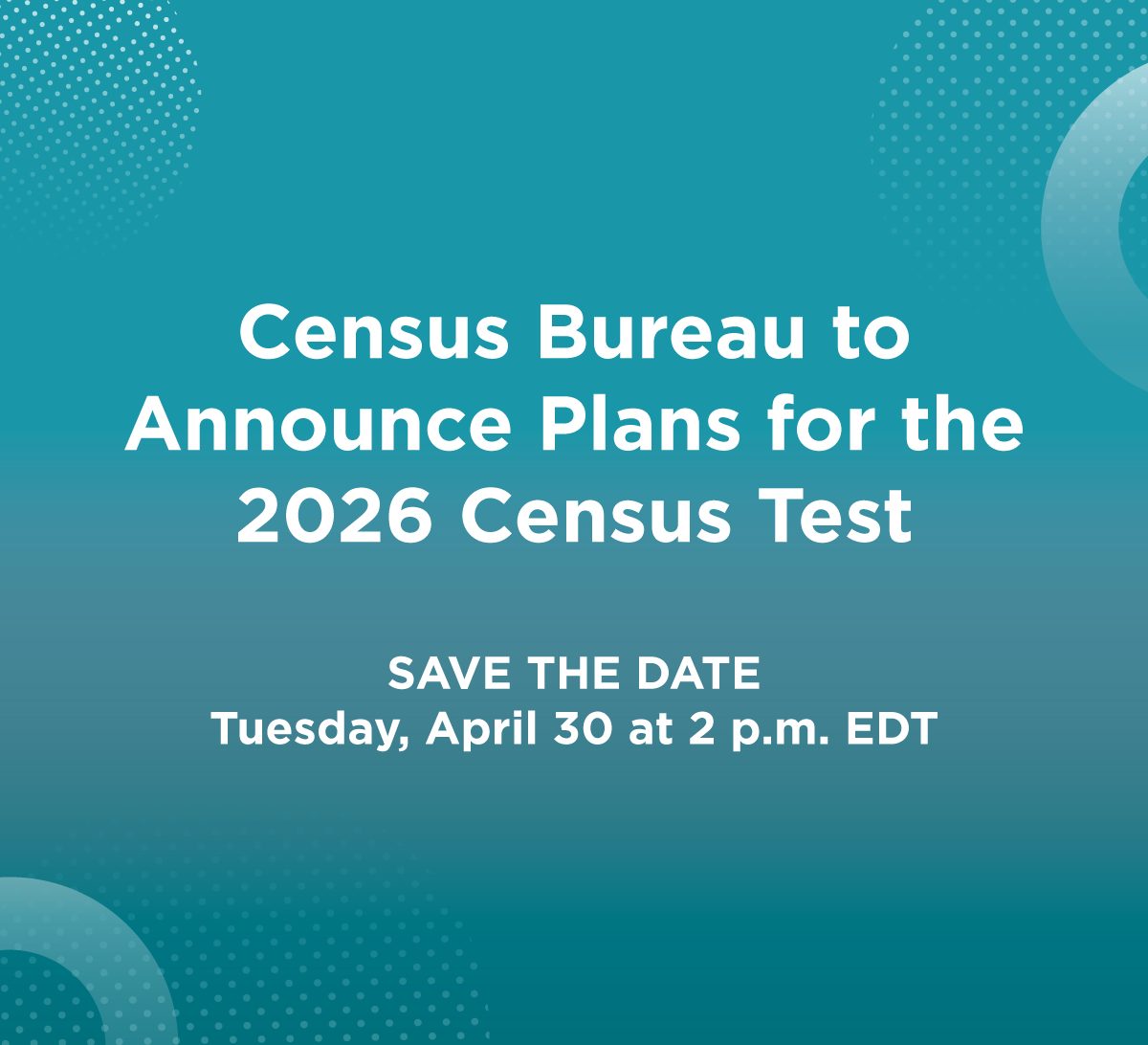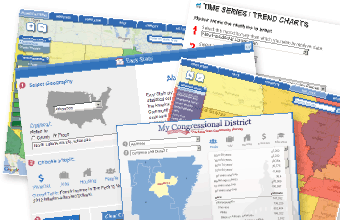Tip Sheet Number 2 — January 27, 2023
Upcoming
2023 Product Calendar
The U.S. Census Bureau has posted anticipated release dates for each regular and recurring statistical product scheduled for release in 2023. These products are listed in the U.S. Census Bureau’s online product calendar, which is updated as needed throughout the year.
2020 Census
Detailed Demographic and Housing Characteristics File A Proof of Concept
The Census Bureau will release a proof of concept for the 2020 Census Detailed Demographic and Housing Characteristics File A (Detailed DHC-A) for public review and feedback. This proof of concept will be based on 2010 Census data. A webinar is planned for the same day at 3 p.m. EST. More information is available in the data products newsletter, Detailed Demographic and Housing Characteristics File A Proof of Concept Coming Later This Month. (Scheduled for release January 31.)
Tribal Listening Session on Detailed Demographic and Housing Characteristics File A Proof of Concept
The U.S. Census Bureau will hold a virtual listening session for tribal leaders, their designated tribal representatives and/or proxies to learn about the Proof of Concept for the 2020 Census Detailed Demographic and Housing Characteristics File A (Detailed
DHC-A) for public review and feedback. The session will include a walkthrough of the Proof of Concept and provide an opportunity to answer any questions in advance of the scheduled tribal consultation February 23, 2023. More information is available in the data products newsletter, Detailed DHC-A Proof of Concept Coming Later This Month. (Event scheduled on February 1, from 3-4:30 p.m. EST.)
Tribal Consultation on Detailed Demographic and Housing Characteristics File A Proof of Concept
The U.S. Census Bureau will hold a virtual tribal consultation for tribal leaders, their designated tribal representatives and/or proxies to seek tribe’s feedback to the Proof of Concept for the 2020 Census Detailed Demographic and Housing Characteristics File A (Detailed DHC-A). More information is available in the data products newsletter, Detailed DHC-A Proof of Concept Coming Later This Month. (Event scheduled on February 23, from 3-4:30 p.m. EST.)
American Community Survey
2017-2021 American Community Survey 5-Year Citizen Voting Age by Race and Ethnicity (CVAP) Special Tabulation
The U.S. Census Bureau will release the 2017-2021 American Community Survey 5-Year Citizen Voting Age by Race and Ethnicity (CVAP) Special Tabulation. This special tabulation is created for use in voting rights analysis and will be published for a series of geographies, down to block-group level. Publication of this special tabulation will only be available for download from the Census Bureau Citizen Voting Age by Race and Ethnicity webpage. (Scheduled for release February 1.)
Demographic
Household Pulse Survey
The experimental Household Pulse Survey is an effort by the U.S. Census Bureau and other federal statistical agencies to provide near real-time data on how the COVID-19 pandemic and changes in social and economic conditions are affecting people’s lives to inform federal and state response and recovery planning. Data collection for phase 3.7 began December 9, with data dissemination, including detailed data tables and public use data files, on a monthly basis. (Scheduled for release February 22.)
School Pulse Panel
The Census Bureau has begun collecting data from schools for the new School Pulse Panel (SPP) as part of efforts to monitor the impact of the COVID-19 pandemic on students and staff in U.S. public schools. The SPP is sponsored by the National Center for Education Statistics and collects data on instructional mode offered, learning loss mitigation strategies, staffing levels, safe and healthy school mitigation strategies, use of technology and more. To learn more, visit the School Pulse Panel webpage.
Economic
2023 LED Partnership Virtual Workshop – New Deadline to Submit Presentations
The 2023 LED Partnership Virtual Workshop will be held March 28-30. This year’s theme is “LED: Big Data Illuminating Local Outcomes.” Presentations will highlight the use of data made possible through the LED Partnership: the Quarterly Workforce Indicators (QWI), the Longitudinal Employer-Household Dynamics (LEHD) Origin-Destination Employee Statistics (LODES), OnTheMap, Job-to-Job Flows (J2J), Post-Secondary Employment Outcomes (PSEO), or Veteran Employment Outcomes (VEO). The deadline to submit presentations has been extended to January 30. Visit 2023 LED Call for Presentations (census.gov) for proposal guidelines and contact information. (Deadline to submit presentations is January 30.)
Economic Census is Underway
The U.S. Census Bureau will begin mailing out invitations to respond to the 2022 Economic Census beginning January 31. Businesses will be asked to submit their responses by March 15. The economic census is the U.S. government's official five-year measure of American businesses and the economy. To learn more about responding to the 2022 Economic Census, visit the Information for Respondents webpage. More information is available on the About the Economic Census webpage and in the press kit. (Scheduled for release January 31.)
2021 County Business Patterns ‘First Look’ Data
The U.S. Census Bureau will release the 2021 County Business Patterns (CBP) First Look data table. This preliminary tabulation includes the number of establishments; employment for the week of March 12, 2021; first quarter payroll; and annual payroll at the NAICS sector level (i.e., 2-digit NAICS) for the nation. The final CBP tables for the 2021 reference year are scheduled for release in April. (First Look scheduled for release February 7.)
“The Disproportionate Impact of the COVID-19 Pandemic on Women in the Workforce”
The U.S. Census Bureau and the Local Employment Dynamics (LED) Partnership in collaboration with the Council for Community and Economic Research (C2ER) and the Labor Market Information (LMI) Institute, will present, “The Disproportionate Impact of the COVID-19 Pandemic on Women in the Workforce.” Women in the workforce faced steeper job losses and slower job recovery than men across the nation due to the COVID-19 pandemic. Research prepared using the LEHD program’s Quarterly Workforce Indicators data will show breakdowns of which industries were heavily impacted, how the impacts to women differed by state, and what recovery looks like in the latest available data. (Schedule for February 14.)
New Total Business Ownership by Demographics Webpage
The U.S. Census Bureau will launch a new webpage that brings together several sources of business owner demographic data into one convenient location for data users. The Total Business Ownership by Demographics (TBOD) page will provide a comprehensive hub for data on selected economic and demographic characteristics for businesses and business owners by sex, ethnicity, race and veteran status. Webpages that previously hosted data from the Survey of Business Owners, Annual Survey of Entrepreneurs, Annual Business Survey and the Nonemployer Statistics by Demographics will be redirected for 90 days once the TBOD site is up. (Scheduled for release February 20.)
Business Trends and Outlook Survey
The U.S. Census Bureau launched a new survey to measure business conditions on an ongoing basis. The Business Trends and Outlook Survey (BTOS) is the successor to the Small Business Pulse Survey (SBPS), a high-frequency survey that measured the effect of changing business conditions during the coronavirus pandemic and other major events like hurricanes on our nation’s small businesses.
BTOS experimental data products are representative of all single-location employer businesses in the U.S. economy, excluding farms. The data will allow greater insight into the state of the economy by providing continuous, timely data for key economic measures. The first data were released October 13 and will continue to be released biweekly and available by sector, state and the 25 most populous metropolitan statistical areas.
Monthly Business Formation Statistics
Business Formation Statistics (BFS) provide timely and high-frequency data on business applications and employer business formations on a monthly basis. The data are available at the state, regional and national level and by industry sector at the national level. The next monthly BFS release is February 10, and will include January 2023 data. Business Formation Statistics - Release Schedule (census.gov).
Stats for Stories
Stats for Stories provides links to timely story ideas highlighting U.S. Census Bureau statistics that relate to current events, observances, holidays and anniversaries. The story ideas are intended to assist the media in story mining and producing content for their respective audiences.
- Groundhog Day: February 2, 2023
- National Women’s Physician Day: February 3, 2023
- Mail Carrier Day: February 4, 2023
- Grammy Awards: February 5, 2023
- National Weatherperson’s Day: February 5, 2023
- Massachusetts 235th State Admission Anniversary (1788): February 6, 2023
- National Inventors’ Day: February 11, 2023
- Super Bowl LVII (57): February 12, 2023
- Valentine’s Day: February 14, 2023
- Singles Awareness Day: February 15, 2023
- Presidents’ Day: February 20, 2023
- Irish American Heritage Month: March
- Women’s History Month: March
- St. Patrick’s Day: March 17
Recently Released
(Released since January 13, 2023)
2020 Census Urban and Rural TIGER Geospatial Data Now Available
January 9 — The Census Bureau recently released two geospatial products containing the 2020 Census Urban Areas. The TIGER/Line Shapefiles and TIGERweb application are now available in the Urban and Rural Classification Press Kit and on the Urban and Rural information page.
2020 Census
2020 Census Count Question Resolution Operation Errata Tables Released
January 23 — The U.S. Census Bureau released the first errata tables for the 2020 Census Count Question Resolution (CQR) operation. The purpose of the 2020 Census CQR is to provide a mechanism for governmental units to request a review of their official 2020 Census results and to help ensure that housing and population counts are correctly allocated to 2020 Census tabulation blocks in the 50 states, District of Columbia, and Puerto Rico. As done after the 2010 Census, releasing errata tables is a standard step in the post decennial CQR process.
American Community Survey
American Community Survey 5-Year Migration Flows
January 26 — The U.S. Census Bureau released migration statistics from the 2016-2020 American Community Survey (ACS). These data tables highlight the geographic mobility of people between counties, metropolitan statistical areas, minor civil divisions in some states and municipalities (municipios) in Puerto Rico. The 5-year data provide estimates of in-migration, out-migration and net migration of movers and nonmovers between origin and destination of these geographies. The Census Flows Mapper tool is updated with the data.
New American Community Survey Data Products Available for the 118th Congress
January 26 — The U.S. Census Bureau released new social, economic, housing and demographic statistics for the 118th Congress. The four data profiles are available for all 435 congressional districts in the Census Bureau’s FTP site and through a tool on the ACS website. The My Congressional District data tool is updated for the 118th Congress. These data products are produced from the 2021 American Community Survey (ACS) 1-year estimates. More information about the ACS is available on the ACS website.
Demographic
CPS ASEC 5-Year Geographic Mobility Tables
January 26 — The U.S. Census Bureau released new tables from the 2020 Current Population Survey Annual Social and Economic Supplement (CPS ASEC) as the 5-year Geographic Mobility detailed table package. These tables contain information on the movement of U.S. residents from one location of residence to another within the previous five years, including details about the types of moves and the characteristics of people who moved.
Civic Engagement and Volunteering Supplement
January 25 — The U. S. Census Bureau, in partnership with AmeriCorps, the federal agency for national service and volunteerism, released the 2021 Current Population Survey (CPS), Civic Engagement and Volunteering Supplement (CEV) on census.gov. The CEV is a robust survey about volunteerism and other forms of civic engagement in the United States. This survey provides measures of geography where individuals are civically active in the United States, the number of individuals involved in unpaid volunteer activities, and the frequency and intensity with which individuals volunteer their time. Visit Volunteering and Civic Life for more information about the survey.
Economic
Oklahoma Added to Post-Secondary Employment Outcomes
January 26 — The U.S. Census Bureau today announced the release of data for Oklahoma and adjusted college graduate earnings to 2020 dollars in the Post-Secondary Employment Outcomes (PSEO) experimental data product. PSEO now includes data on 680 institutions, which cover approximately 26% of all college graduates.
Facts for Features
National Black (or African American) History Month: February 2023
January 12 — To commemorate and celebrate the contributions to our nation by people of African descent, the U.S. Census Bureau presents a collection of demographic and economic statistics about the Black community.
America Counts: Stories Behind the Numbers
America Counts tells the stories behind the numbers in a new and inviting way. We feature stories on various topics such as families, housing, employment, business, education, the economy, emergency preparedness and the population. New stories include:
Stats for Stories
Stats for Stories provides links to timely story ideas highlighting the Census Bureau’s newsworthy statistics that relate to current events, observances, holidays and anniversaries. The story ideas are intended to assist the media in story mining and producing content for their respective audiences
- American Heart Month: February 2023
- National Spouses Day: January 26, 2023
- Lunar New Year, January 22, 2023
- National Popcorn Day: January 19, 2023
- Martin Luther King, Jr. Day: January 16, 2023
- National Pharmacist Day: January 12, 2023
- National Milk Day: January 11, 2023
- Connecticut 235th Anniversary of Statehood (1788): January 9, 2023
- Georgia 235th Anniversary of Statehood (1788): January 2, 2023
- New Year’s Day: January 1, 2023
- National Hot Tea Month: January 2023
- National Poverty in America Awareness Month: January 2023
Blogs
A Look Ahead: 2023
Written by: Robert L. Santos, Director, U.S. Census Bureau
January 23 — So here we are in 2023. The U.S. Census Bureau has endured the throes of 2020, when multiple challenges including a global pandemic threatened the completion of our constitutionally mandated decennial census. But complete it, we did, and our final 2020 Census data products — the most detailed to date — will be released later this year. And our other censuses and surveys have continued, unabated. Our work on censuses and surveys these past years has taught us that we can be both innovative and nimble. In fact, we have absorbed those attributes into our strategic planning and our ongoing transformation and modernization initiative. We are reengineering our processes, our practices and indeed our thinking about how a federal statistical agency operates in the 21st century.
Resources
Emergency Management/Disaster Resources
When major disasters strike, visit our Emergency Management page for demographic and economic data on impacted areas. Each disaster will include data from our key emergency management tools: OnTheMap for Emergency Management, Community Resilience Estimates, Census Business Builder: Regional Analyst Edition and other useful resources.
Learn What Surveys Are Being Conducted in Your Community
See which of the U.S. Census Bureau’s 130-plus annual surveys are being conducted in your community. In a variety of surveys and censuses, evolving from the first census in 1790, the Census Bureau provides official information about America’s people, businesses, industries and institutions. Learn more about surveys currently being conducted in each Census Bureau region:
Data Tools
Listed below are a few of the U.S. Census Bureau’s interactive applications used to access statistics from our 130-plus annual surveys. A complete list can be accessed on the Census Bureau’s Data Tools and Apps webpage.
- Census COVID-19 Data Hub — This site provides users demographic risk factor variables along with economic data on 20 key industries impacted by Coronavirus.
- Community Resilience Estimates — The Census Bureau’s CRE provide an easily understood metric for how at-risk every neighborhood in the United States is to the impacts of COVID-19.
- LED Extraction Tool — Provides easy access to the raw data products produced by the Longitudinal Employer-Household Dynamics (LEHD) program.
Training Opportunities
Census Bureau Training Opportunities
Webinars are available on a regular basis to help the public access and use U.S. Census Bureau statistics. These free sessions, which are 60 to 90 minutes each, show users how to navigate Census Bureau databases and mapping tools and find demographic and economic statistics at the local or national level. Descriptions of upcoming sessions are available on our Census Academy page. Login details are provided at least one week before a webinar.
- 2020 Census Race and Ethnicity Data: The Detailed DHC-A Proof of Concept (Tuesday, January 31, 3-4 p.m. EST)
- The Disproportionate Impact of the COVID-19 Pandemic on Women in the Workforce (Tuesday, February 14, 1:30-3:00 p.m. EST)
- Census Tools for the Grant Writing Trade (Thursday, February 16, 2-3:30 p.m. EST)
- How to Make a Data-Driven Business Plan Using Census Bureau Data (Thursday, February 23, 2-3:30 p.m. EST)
Archived Training Resources
Visit the Census Bureau’s Educational Resource Library for previously recorded, free training available at your convenience. The library includes presentations, recorded webinars, tutorials and other helpful materials.
###








